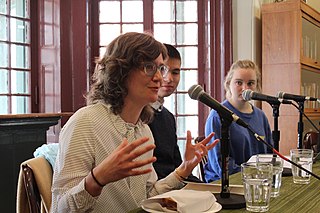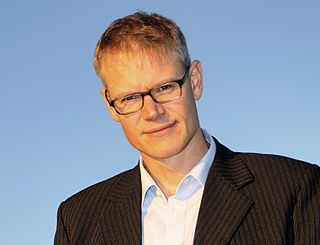
Scientific American, informally abbreviated SciAm or sometimes SA, is an American popular science magazine. Many scientists, including Albert Einstein and Nikola Tesla, have contributed articles to it, with more than 150 Nobel Prize-winners being featured since its inception.

James Harris Simons was an American hedge fund manager, mathematician, and philanthropist. He was the founder of Renaissance Technologies, a quantitative hedge fund based in East Setauket, New York. He and his fund are known to be quantitative investors, using mathematical models and algorithms to make investment gains from market inefficiencies. Due to the long-term aggregate investment returns of Renaissance and its Medallion Fund, Simons was described as the "greatest investor on Wall Street," and more specifically "the most successful hedge fund manager of all time".

Deborah Blum is an American science journalist and the director of the Knight Science Journalism program at the Massachusetts Institute of Technology. She is the author of several books, including The Poisoner's Handbook (2010) and The Poison Squad (2018), and has been a columnist for The New York Times and a blogger, via her blog titled Elemental, for Wired.

Steven Henry Strogatz, born August 13, 1959, is an American mathematician and author, and the Susan and Barton Winokur Distinguished Professor for the Public Understanding of Science and Mathematics at Cornell University. He is known for his work on nonlinear systems, including contributions to the study of synchronization in dynamical systems, and for his research in a variety of areas of applied mathematics, including mathematical biology and complex network theory.

The Knight Science Journalism program offers 9-month research fellowships, based at its headquarters at the MIT School of Humanities, Arts, and Social Sciences, to elite staff and freelance journalists specializing in coverage of science and technology, medicine, or the environment. Fellows are chosen from an international application pool in a competitive process each spring, and reside in Cambridge, Massachusetts, for two semesters of audited coursework and research at MIT, Harvard, and surrounding institutions.

Albrecht Beutelspacher is a German mathematician and founder of the Mathematikum. He is a professor emeritus at the University of Giessen, where he held the chair for geometry and discrete mathematics from 1988 to 2018.
Thomas Zeller Jr. is an American journalist who has covered poverty, technology, energy policy and the environment, among other topics, for a variety of publications, including 12 years on staff as a writer and editor at The New York Times. He has also held staff positions at National Geographic Magazine and The Huffington Post.

Sylvia Serfaty is a French mathematician working in the United States. She won the 2004 EMS Prize for her contributions to the Ginzburg–Landau theory, the Henri Poincaré Prize in 2012, and the Mergier–Bourdeix Prize of the French Academy of Sciences in 2013.
The Simons Foundation is an American private foundation established in 1994 by Marilyn and Jim Simons with offices in New York City. As one of the largest charitable organizations in the United States with assets of over $5 billion in 2022, the foundation's mission is to advance the frontiers of research in mathematics and the basic sciences. The foundation supports science by making grants to individual researchers and their projects.

Henry Cohn is an American mathematician. He is a principal researcher at Microsoft Research and an adjunct professor at MIT. In collaboration with Abhinav Kumar, Stephen D. Miller, Danylo Radchenko, and Maryna Viazovska, he solved the sphere packing problem in 24 dimensions. In 2003, with Chris Umans he initiated a group-theoretic approach to matrix multiplication, and is a core contributor to its continued development with various coauthors.
Undark Magazine is a nonprofit online publication exploring science as a "frequently wondrous, sometimes contentious, and occasionally troubling byproduct of human culture." The name Undark is a deliberate reference to a radium-based luminous paint product called Undark that ultimately proved toxic if not deadly for those who handled it.

3Blue1Brown is a math YouTube channel created and run by Grant Sanderson. The channel focuses on teaching higher mathematics from a visual perspective, and on the process of discovery and inquiry-based learning in mathematics, which Sanderson calls "inventing math". As of May 2024, the channel has 6.16 million subscribers.
Natalie Ann Wolchover is a science journalist. She is a senior writer and editor for Quanta Magazine, and has been involved with Quanta's development since its inception in 2013. In 2022 she won a Pulitzer Prize for Explanatory Reporting.

Quanta is an open access scientific journal covering the foundations of quantum mechanics, mathematical physics, and philosophy of science. The first volume, dedicated to the work of Karl Popper on foundations of quantum mechanics, was published on November 15, 2012. The editor-in-chief and publisher is Danko Georgiev.

Frank A. Farris is an American mathematician. He is a professor of Mathematics and Computer Science at Santa Clara University. He is also an editor, author, and artist whose work concerns mathematical topics. Farris is known primarily for mathematical exposition, his creation of visual mathematics through computer science, and advocacy for mathematical art as a discipline.

Andrew Victor Sutherland is an American mathematician and Principal Research Scientist at the Massachusetts Institute of Technology. His research focuses on computational aspects of number theory and arithmetic geometry. He is known for his contributions to several projects involving large scale computations, including the Polymath project on bounded gaps between primes, the L-functions and Modular Forms Database, the sums of three cubes project, and the computation and classification of Sato-Tate distributions.

Brooke Borel is a science journalist, scientist,and author.

Claus Peter Ortlieb was a German mathematician (PhD), critic of work, critic of political economy, and a critic of contemporary science, especially regarding its use of mathematics. He was an editor for the journal EXIT!.

Carsten Könneker is a German science journalist and science communication researcher. From 2010 to 2019, he was editor-in-chief of Spektrum der Wissenschaft, the German edition of Scientific American. From 2012 to 2018, he was professor of science communication and science studies at Karlsruhe Institute of Technology, and founding director of the German National Institute for Science Communication, Karlsruhe. From 2019 to 2022, he was one of the managing directors of the Klaus Tschira Foundation.















